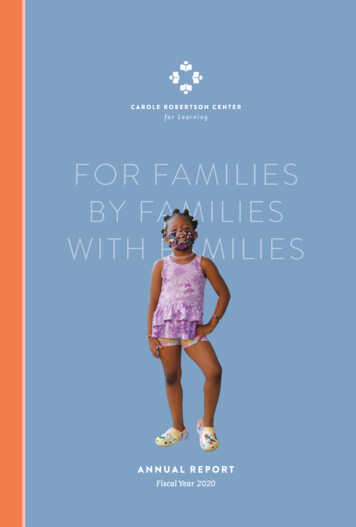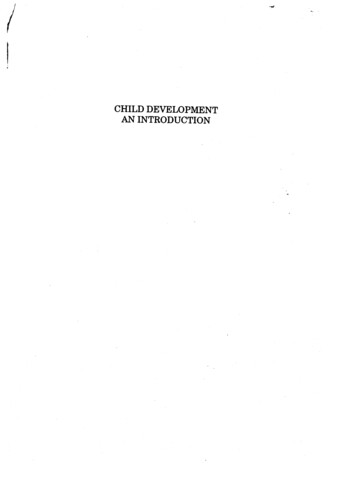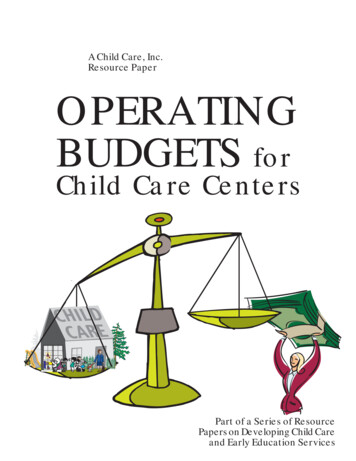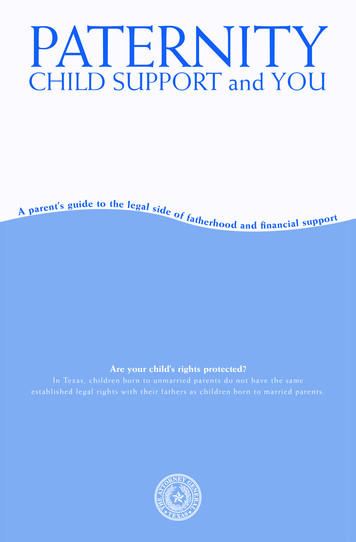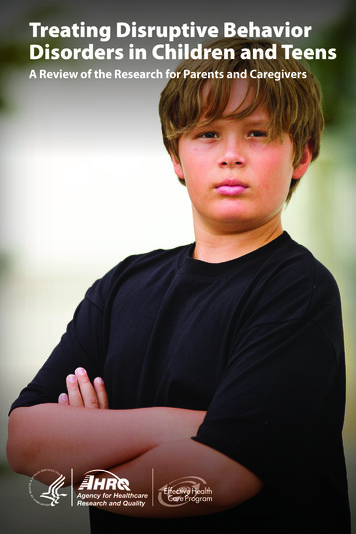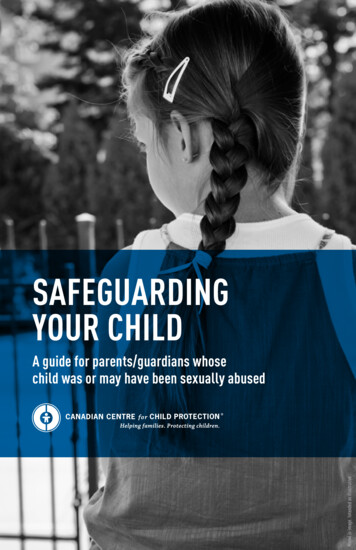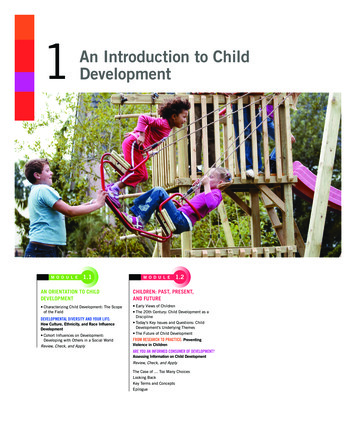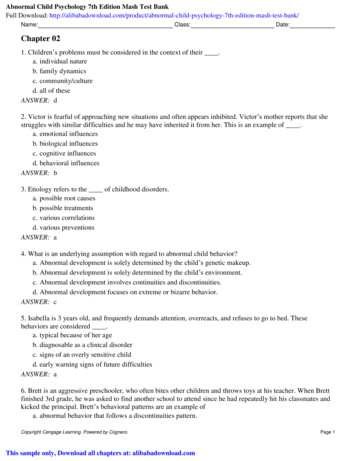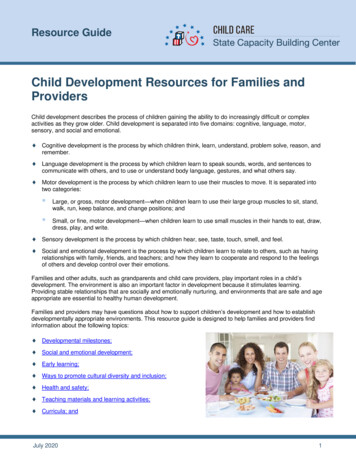
Transcription
Resource GuideChild Development Resources for Families andProvidersChild development describes the process of children gaining the ability to do increasingly difficult or complexactivities as they grow older. Child development is separated into five domains: cognitive, language, motor,sensory, and social and emotional. Cognitive development is the process by which children think, learn, understand, problem solve, reason, andremember. Language development is the process by which children learn to speak sounds, words, and sentences tocommunicate with others, and to use or understand body language, gestures, and what others say. Motor development is the process by which children learn to use their muscles to move. It is separated intotwo categories: Large, or gross, motor development—when children learn to use their large group muscles to sit, stand,walk, run, keep balance, and change positions; andSmall, or fine, motor development—when children learn to use small muscles in their hands to eat, draw,dress, play, and write. Sensory development is the process by which children hear, see, taste, touch, smell, and feel. Social and emotional development is the process by which children learn to relate to others, such as havingrelationships with family, friends, and teachers; and how they learn to cooperate and respond to the feelingsof others and develop control over their emotions.Families and other adults, such as grandparents and child care providers, play important roles in a child’sdevelopment. The environment is also an important factor in development because it stimulates learning.Providing stable relationships that are socially and emotionally nurturing, and environments that are safe and ageappropriate are essential to healthy human development.Families and providers may have questions about how to support children’s development and how to establishdevelopmentally appropriate environments. This resource guide is designed to help families and providers findinformation about the following topics: Developmental milestones; Social and emotional development; Early learning; Ways to promote cultural diversity and inclusion; Health and safety; Teaching materials and learning activities; Curricula; andJuly 20201
Child Development Resources for Families and Providers A book distribution list.The State Capacity Building Center does not endorse any non-federal organization, publication, or resource.Developmental MilestonesBackAll children are unique and develop at their own rate. Developmental milestones are skills that children reach intheir learning and growth, through experiences with adults, families, and other peers. Developmental milestonesare found within the following domains: social and emotional, physical, cognitive, and speech and languagedevelopment.The following table provides examples of some developmental milestones children from birth to 5 years of agemay be able to accomplish by the end of each age range.Birth to 5 Developmental MilestonesCategorySkills2 monthsSocial and Emotional Begins to smile at people Can briefly calm himself (may bring hands to mouth and suck onhand)Language/Communication Coos, makes gurgling sounds Turns head towards soundsCognitive Pays attention to faces Begins to follow things with eyes and recognize people at a distanceMovement/PhysicalDevelopment Can hold head up and begins to push up when lying on tummy Makes smoother movements with arms and legs6 monthsSocial and Emotional Knows familiar faces and begins to know if someone is a stranger Likes to play with others, especially parentsLanguage/Communication Responds to sounds by making sounds Strings vowels together when babbling (“ah,” “eh,” “oh”) and likestaking turns with parent while making soundsCognitive Looks around at things nearby Brings things to mouthMovement/PhysicalDevelopment Rolls over in both directions (front to back, back to front) Begins to sit without support1 yearSocial and EmotionalJuly 2020 Is shy or nervous with strangers Cries when mom or dad leaves2
Child Development Resources for Families and ProvidersBirth to 5 Developmental MilestonesCategorySkillsLanguage/Communication Responds to simple spoken requests Uses simple gestures, like shaking head “no” or waving “bye-bye”Cognitive Explores things in different ways such as shaking, banging, throwing Finds hidden things easilyMovement/PhysicalDevelopment Gets to a sitting position without help Pulls up to stand, walks holding on to furniture (“cruising”)2 YearsSocial and Emotional Copies others, especially adults and older children Gets excited when with other childrenLanguage/Communication Points to things or pictures when they are named Knows names of familiar people and body partsCognitive Finds things even when hidden under two or three covers Begins to sort shapes and colorsMovement/PhysicalDevelopment Stands on tiptoe Kicks a ball3 YearsSocial and Emotional Copies adults and friends Shows affection for friends without promptingLanguage/Communication Follows instructions with two or three steps Can name most familiar thingsCognitive Can work toys with buttons, levers, and moving parts Plays make-believe with dolls, animals, and peopleMovement/PhysicalDevelopment Climbs well Runs easily4 YearsSocial and Emotional Enjoys doing new things Plays “Mom” and “Dad”Language/Communication Knows some basic rules of grammar, such as correctly using “he” and“she” Sings a song or says a poem from memory such as the “Itsy BitsySpider” or the “Wheels on the Bus”July 20203
Child Development Resources for Families and ProvidersBirth to 5 Developmental MilestonesCategorySkillsCognitive Names some colors and some numbers Understands the idea of countingMovement/PhysicalDevelopment Hops and stands on one foot up to two seconds Catches a bounced ball most of the time5 yearsSocial and Emotional Wants to please friends Wants to be like friendsLanguage/Communication Speaks very clearly Tells a simple story using full sentencesCognitive Counts 10 or more things Can draw a person with at least six body partsMovement/PhysicalDevelopment Stands on one foot for 10 seconds or longer Hops; may be able to skipNote: This information is from the Centers for Disease Control and Prevention’s Developmental Milestones section of itswebsite at x.html.Although these milestones are based on age, achieving them varies from child to child. Families and providerscan help children reach developmental milestones by talking or playing with them or providing an environmentthat stimulates development.Online Resources Parents Guide to Developmental Milestones (n.d.), Child Mind l-milestones/ Milestones (n.d.), Pathways.org, https://pathways.org/all-ages/milestones/What are developmental delays?A developmental delay refers to a child’s inability to learn or master an expected activity within her age range.Developmental delays could be the result of either external or internal factors, such as a lack of environmentalstimulation, premature birth, or a learning disability. Families and providers can help children by learning the signsof developmental delay and knowing when to refer children to early intervention.The following organizations provide information about developmental milestones and developmental delays.July 20204
Child Development Resources for Families and ProvidersOrganizationsAmerican Academy of Pediatrics (AAP)Phone: 847-434-4000Website: http://www.aap.org/AAP works to provide general health and well-being information for families of children up to age 21. The AAPwebsite offers information about children’s heath, including development and developmental delays.Centers for Disease Control and Prevention (CDC)Infant/Toddler Resource GuideU.S. Department of Health and Human ServicesThis resource can help child careprofessionals develop policies andpractices for high-quality infant andtoddler care. This guide contains articles,videos, links, and learning materials forstate level professionals, infant/toddlercare providers, as well as professionaldevelopment and technical assistanceprofessionals, to develop their skills andknowledge. Available esource-guideToll free: 800-232-4636Website: http://www.cdc.gov/Website in Spanish: http://www.cdc.gov/spanish/CDC’s mission is to protect and improve the health and safety of thegeneral public. Its site offers information about child development anddevelopmental delays Talaris Research InstitutePhone: 206-859-5600Available in es-y-ninos-pequenosWebsite: http://www.talaris.org/Talaris is dedicated to discovering how children think, feel, and learn. It also produces a research-based timelinethat can serve as a general guide to how children grow.What is a developmental screening?A developmental screening is a procedure for health practitioners, families, and child care providers to identifywhether children are developing within the expected range. Screening can result in earlier detection, identification,and treatment of developmental delays.The following organizations and online resources provide additional information about developmental screenings,disabilities, and autism.OrganizationsAutism Speaks – Material en EspañolWebsite: http://www.autismspeaks.org/Website in Spanish: urcesJuly 20205
Child Development Resources for Families and ProvidersAutism Speaks provides a wide range of information and resources about autism in both Spanish and English.Center for Parent Information and Resources Resource Library (CPIR)Website: https://www.parentcenterhub.org/resourcelibrary/ (in English and Spanish)CPIR has a variety of resources on child development topics. In addition, it houses the resources from theNational Dissemination Center for Children with Disabilities (NICHCY), a project that collected a wealth ofresources on disability topics but was defunded. Resources are available in English and Spanish.First Signs, Inc.Phone: 978-346-4380Email: info@firstsigns.orgWebsite: http://www.firstsigns.org/First Signs is dedicated to early identification and intervention of childhood learning delays and disorders. Thefollowing resources are available: Audiological Screening (n.d.), http://www.firstsigns.org/screening/audio.htm; Autism Screening (n.d.), http://www.firstsigns.org/screening/asd.htm; Developmental Screening (n.d.), http://www.firstsigns.org/screening/dev.htm; Diagnosis and Treatment (n.d.), http://www.firstsigns.org/treatment/; Hallmark Developmental Milestones (n.d.), m; Lead Screening (n.d.), http://www.firstsigns.org/screening/lead.htm; Screening Guidelines (n.d.), ; Screening Tools (n.d.), http://www.firstsigns.org/screening/tools/index tools.htm; and Screening: Making Observations (n.d.), http://www.firstsigns.org/screening/.Online Resources Assure the Best for Your Baby’s Physical Development (n.d.), the Pathways Awareness BabyOK PDForder.pdf Inclusion Planning Checklist: Center-Based Early Care and Education Programs (n.d.), SpecialQuest Birth–Five: Head Start/Hilton Foundation Training Program, http://www.eita-pa.org/assets/9 Inclusion-PlanningChecklist-for-Centers.pdf Inclusion Planning Checklist: Home-Visiting Programs (n.d.), SpecialQuest Birth–Five: Head Start/HiltonFoundation Training Program, .pdf Developmental Monitoring and Screening (June 2020), Centers for Disease Control and Prevention, NationalCenter for Birth Defects and Developmental /screening.htmlJuly 20206
Child Development Resources for Families and Providers Screening and Diagnosis of Autism Spectrum Disorder (March 2020), Centers for Disease Control andPrevention, http://www.cdc.gov/ncbddd/autism/screening.html Delayed Speech or Language Development (November 2019), reviewed by Julia K. Hartnett for munication/not talk.htmlAvailable in Spanish at http://kidshealth.org/parent/en espanol/emociones/not talk esp.html Birth to 5: Watch Me Thrive—Families (Reviewed July 2017), the U.S. Department of Health and HumanServices and the U.S. Department of Education, velopment/watch-me-thrive/families Birth to Five: Watch Me Thrive! An Early Care and Education Provider’s Guide for Developmental andBehavioral Screening (2014), the U.S. Department of Health and Human Services and the U.S. Departmentof Education, e providers guide march2014.pdfAvailable in Spanish at e providers guide spanish 508.pdf Checklists for Providing/Receiving Early Intervention Supports in Child Care Settings (September 2012),Dathan Rush and M’Lisa Shelden, Center for the Advanced Study of Excellence in Early Childhood andFamily Support Practices, Family and Infant Preschool Program, J Iverson Riddle Developmental ools/casetool vol6 no4.pdfSocial and Emotional DevelopmentBackSocial and emotional development is integral to all aspects of a child’s growth, including intellectual, physical,behavioral, and moral development. Beginning from birth, nurturing and stable relationships with caring adults areessential to healthy human development.The following resources provide information for families and providers about social and emotional development,including information about temperaments, separation anxiety, and other related issues.OrganizationsAmerican Academy of Child and Adolescent Psychiatry(AACAP)Phone: 202-966-7300Website: http://www.aacap.org/AACAP developed 88 Facts for Families fact sheets to provideconcise and up-to-date information about issues that affect children, teenagers, and their families. Thesedocuments are available athttps://www.aacap.org/AACAP/Families and Youth/Facts for Families/Layout/FFF Guide-01.aspx.Center for Early Childhood Mental Health Consultation, Georgetown University Center for Child andHuman Development and the Office of Head StartWebsite: https://www.ecmhc.org/index.htmlThis organization focuses on supporting mental health for children, families, and child care providers.July 20207
Child Development Resources for Families and ProvidersCenter on the Social and Emotional Foundations for Early Learning (CSEFEL)Phone: 877-275-3227Website: http://csefel.vanderbilt.edu/CSEFEL focuses on promoting the social and emotional development of young children. Resources for teachersand providers are available at html. Resources for families areavailable at http://csefel.vanderbilt.edu/resources/family.html and resources in Spanish are available tml.Zero to ThreePhone: 202-638-1144Website: http://www.zerotothree.org/This organization focuses on educating the public and promoting development of infants and toddlers.Online Resources Selecting the Right Child Care Setting for Your Infant or Toddler (2019), Child Care oads/2016/05/Selecting the Right Child Care Setting for Your Infant or Toddler.pdf.Available in Spanish at ninos-para-su-bebe-o-nino-pequeno.pdf Separation Anxiety (October 2016), reviewed by Jennifer Shroff Pendley for eelings/sep anxiety.htmlAvailable in Spanish at http://kidshealth.org/parent/en espanol/emociones/separation anxiety esp.html What Do We Know About Emotional Development in Early Childhood? (2014), the Urban Child development How to Understand Your Child’s Temperament (June 2009), the American Academy of ur-ChildsTemperament.aspx Strategies and Solutions for Handling a Difficult Child (November 2009), the American Academy of ions-ForHandling-A-Difficult-Child.aspxWhere can I get information about positive discipline, child guidance,and understanding challenging behaviors?The following online resources provide information about strategies for behavior management and guidance forfamilies, teachers, and child care providers. These resources also provide information about discipline.July 20208
Child Development Resources for Families and ProvidersBehavior Management Recommended Practices: Preventing Challenging Behavior in Young Children: Effective Practices (n.d.), byPeter J. Alter and Maureen A. Conroy, Center for Evidenced-Based docs/RecommendedPractices preventing-challenging-behavior.pdf Recommended Practices: Supporting Infants and Toddlers with Challenging Behavior (n.d.), by Lise Fox,Center for Evidenced-Based docs/RecommendedPractices supporting-infants-toddlers.pdf Biting (June 2018), reviewed by Lauren O’Donnell for Kids Health, https://kidshealth.org/en/parents/stopbiting.html, Available in Spanish at html?WT.ac pairedLink Tips for Responding to Challenging Behavior in Young Children (Jan 2017) by Phil Strain, Jaclyn Joseph,Mary Louise Hemmeter, Erin Barton, and Lise Fox, Center for Evidenced-Based /docs/PEP Tips-responding-challenging-behavior.pdf Fighting and Biting (Updated April 2016), Facts for Families No. 81, the American Academy of Child &Adolescent Psychiatry,https://www.aacap.org/aacap/families and youth/facts for families/FFF-Guide/Fighting-And-Biting-081.aspx Toddlers and Biting: Finding the Right Response (Feb 2016), Zero to ddlers-and-biting-finding-the-right-response Early Head Start TA Paper No. 16: Individualizing Care for Infants and Toddlers—Part 1 (2014), the Office ofHead Start, Administration for Children and Families, U.S. Department of Health and Human lt/files/pdf/ehs-ta-16.pdf My Teacher Wants to Know in Creating Teaching Tools for Young Children with Challenging Behaviors: AUser’s Manual (2009), by Bobbie Vaughn, Lise Fox, and Rochelle Lentini, published by the Louis de la ParteFlorida Mental Health Institute, University of South ramid/pbs/TTYC/tools.htmlDiscipline Discipline and Limit Setting (n.d.), Zero to line-and-limitsetting Instead of Discipline, Use Guidance (2020), by Dan Gartrell,National Association for the Education of Young feb2020/usingguidance-not-discipline What’s the Best Way to Discipline My Child? (Nov 2018), theAmerican Academy of ne/Pages/Disciplining-YourChild.aspx How Can Parents Discipline Their Child Without Spanking?(June 2018), reviewed by Lauren O’Donnell for Kids html?WT.ac p-raParents and child care providers maywant to contact their state licensingagency for information about regulationsestablished by their state regardingcorporal punishment in child caresettings. The National Database ofChild Care Licensing Regulationscontains direct website links to state childcare licensing regulation documents andlicensing agency contact information.Users can access, download, and searchstate child care licensing regulations thatapply to child care centers, family childcare homes, and other licensed child careprograms. The database is available athttps://childcareta.acf.hhs.gov/licensing. Culturally Appropriate Positive Guidance with Young Children(2017) by Zeynep Isik-Ercan, National Association for theJuly 20209
Child Development Resources for Families and ProvidersEducation of Young Children, lturally-appropriatepositive-guidance The Discipline Dilemma: Guiding Principles for Managing Challenging Behaviors (December 2016), Zero toThree, llenging-behaviors Using Words to Discipline Children (Revised 2015) an Illinois Early Learning Project Tip Sheet, the IllinoisEarly Learning s/wordsdiscipline/.Available in Spanish at dsdiscipline-sp/Available in Polish at dsdiscipline-pol/Where can I get information about bullying?Bullying is the aggressive and intentional act of physically or emotionally hurting others. The effect of bullying onchildren depends on the severity and duration of the behavior, but ranges from depression, low self-esteem,anxiety, and loneliness, to thoughts of suicide.The following organizations and online resources provide information and resources about bullying.OrganizationsNational Center for Bullying PreventionPACER Center Champions for Children with DisabilitiesPhone: 952-838-9000Website: http://www.pacer.org/bullying/The PACER Center offers resources for families and professionals about bullying as it relates to children withspecial needs. Resources are also available in Spanish and Somali.Stopbullying.govWebsite: http://www.stopbullying.govStopbullying.gov is a campaign that offers resources for kids, families, and educators about bullying and ways tostop it.Online Resources Understanding the Roles of Early Education and Child Care Providers in Community-Wide BullyingPrevention Efforts (n.d.), Stopbullying.gov, 01709/hrsa guide early-education-child-care-providers 508v2.pdfAvailable in Spanish at 01709/hrsa guide proveedores de cuidado infantil y educacio%25C3%25ACn inicial 508.pdf Bullying (updated April 2016), Facts for Families No. 80, the American Academy of Child & AdolescentPsychiatry, http://www.aacap.org/AACAP/Families and Youth/Facts for Families/FFF-Guide/Bullying080.aspxJuly 202010
Child Development Resources for Families and Providers Help Your Child Recognize the Signs of Bullying (2016), published by the PACER BP-2.pdf.Available in Spanish at pdf Bullying: It’s Not OK (Nov 2015), the American Academy of Ok.aspx What If Your Child IS the One Showing Bullying Behavior? (2015), a PACER Center Action InformationSheet, http://www.pacer.org/parent/php/PHP-c109.pdf Helping Kids Deal With Bullies (reviewed July 2013), reviewed by D’Arcy Lyness for ehavior/bullies.html.Available in Spanish at http://kidshealth.org/parent/en espanol/emociones/bullies esp.htmlHow do I help a grieving child?Understanding death and the process of grief is different for all children. Families and child care providers mayfind it difficult to talk to children about death because they may also be coping with the pain of losing the lovedone or may be afraid of causing the child additional pain.The following organizations and online resources provide information about children and grief, and how familiesand other adults can help children understand death and handle grief.OrganizationsBereaved Parents of the USA (BP/USA)Phone: 708-748-7866Website: http://www.bereavedparentsusa.org/BP/USA offers support to bereaved parents, siblings, grandparents, and others who have experienced the loss ofa child.The Compassionate Friends (TCF)Phone: 877-969-0010Website: https://www.compassionatefriends.org/TCF helps families with grief following the death of a child and provides information to help others be supportive.The Dougy Center for Grieving Children and FamiliesPhone: 886-775-5683Website: http://www.dougy.org/The center is a resource to help children and families with grief and loss. Services are also available in Spanish.July 202011
Child Development Resources for Families and ProvidersOnline Resources The Child’s Loss: Death, Grief, and Mourning (n.d.), by Bruce D. Perry and Jana Rubenstein, ndgrief-1.htm Traumatic Experiences (n.d.), Sesame Street in topics/traumatic-experiences/Available in Spanish at uma/ Trauma and Stress (n.d.), Zero to Three, ma-and-stress Resource Guide: Emergency Preparedness, Response and Recovery Resources for Child Care Programs(February 2020), the State Capacity Building Center, -child-care-programs [the resource includes informationabout helping children and families cope with trauma] 5 Do’s and Don’ts of Helping Kids Cope with Grief and Loss (May 2019), by Megan Zander, eath-to-kids.html How to Implement Trauma-informed Care to Build Resilience to Childhood Trauma (May 2019) by JessicaDym Bartlett and Kate Steber, Child Trends, -childhood-trauma Childhood Traumatic Grief: Information for Parents and Caregivers (2019), the National Child TraumaticStress Network, s/factsheet/childhood traumatic grief information for parents and caregivers.pdf Children’s Responses to Crises and Tragic Events, (Last Updated October 2018), the Office of Head Start,Early Learning and Knowledge Center, s-responses-crisestragic-events “Grief and Children” (June 2018), Facts for Families No. 8, the American Academy of Child & amilies and youth/facts for ly LearningBackEarly learning refers to a child’s ability to begin learning at a young age. From birth to school age, children’s earlyyears serve as a foundation for development and growth, which are also influenced by their experiences,environment, and interactions with their primary caregivers, including child care providers. In addition, scientists’recent research on how the brain works has led to new understanding about how young children develop andlearnBrain DevelopmentThe following organizations and online resources provide information about young children’s brain development.July 202012
Child Development Resources for Families and ProvidersOrganizationsNational Scientific Council on the Developing ChildPhone: 617-496-0578Email: developingchild@harvard.eduWebsite: ncil/The National Scientific Council on the Developing Child is amultidisciplinary collaboration made up of many of the nation’s leadingscientists in early childhood development. It combines cutting-edge,interdisciplinary scientific knowledge on early child development withcommunication methods designed to ensure public understanding ofthat science.Neuroscience for KidsWebsite: euroscience for Kids was created so that students and educators alike can obtain useful, easy-to-understandinformation about neuroscience.Zero To Three: National Center for Infants, Toddlers, and FamiliesPhone: 202-638-1144Website: http://www.zerotothree.org/This national organization focuses exclusively on issues affecting infants and toddlers.Online Resources Brain-Building Tips for Parents (n.d.), Better Brains for Better Babies, https://www.bbbgeorgia.org/parents Brain Building Resources (n.d.), Child Care Aware, urces/ Brain Development (n.d.), Zero to Three, n-development Building Baby’s Brain: The Basics (Revised June 2019), by Diane Bales for the University of GeorgiaExtension, /files/pdf/C%201053-01 4.PDF Brain and Nervous System (Reviewed May 2019), by Larissa Hirsch and KidsHealth Medical Experts forKidsHealth, http://kidshealth.org/parent/general/body basics/brain nervous system.htmlAvailable in Spanish at http://kidshealth.org/parent/en espanol/general/brain nervous system esp.htmlEarly Literacy and LanguageRecent research has brought about a new understanding of how infants, toddlers, and preschoolers learnlanguage and early literacy skills. This research has influenced formal and informal strategies that families andJuly 202013
Child Development Resources for Families and Providersearly childhood educators use to help young children arrive at kindergarten with the early literacy skills andmotivation the
Cognitive development is the process by which children think, learn, understand, problem solve, reason, and remember. Language development is the process by which children learn to speak sounds, words, and sentences to communicate with others, and to use or



